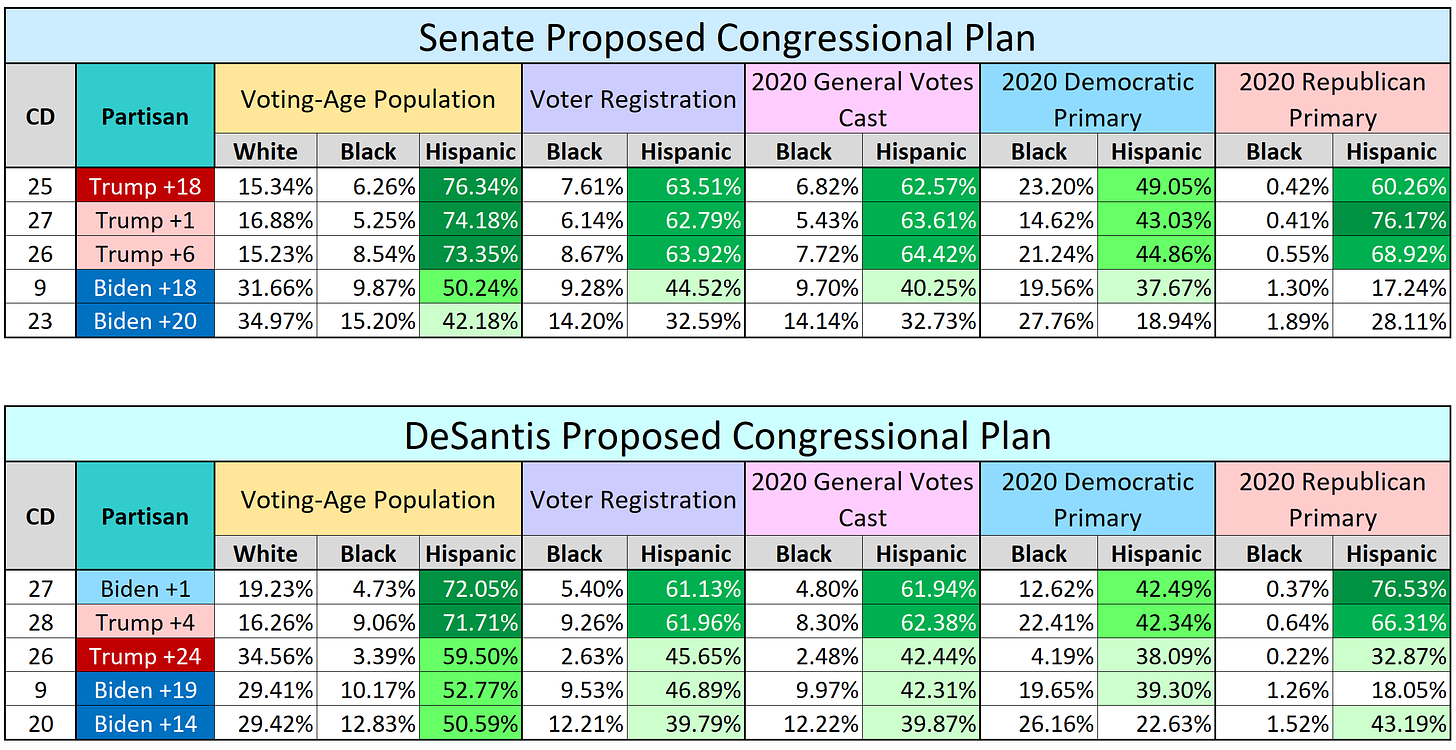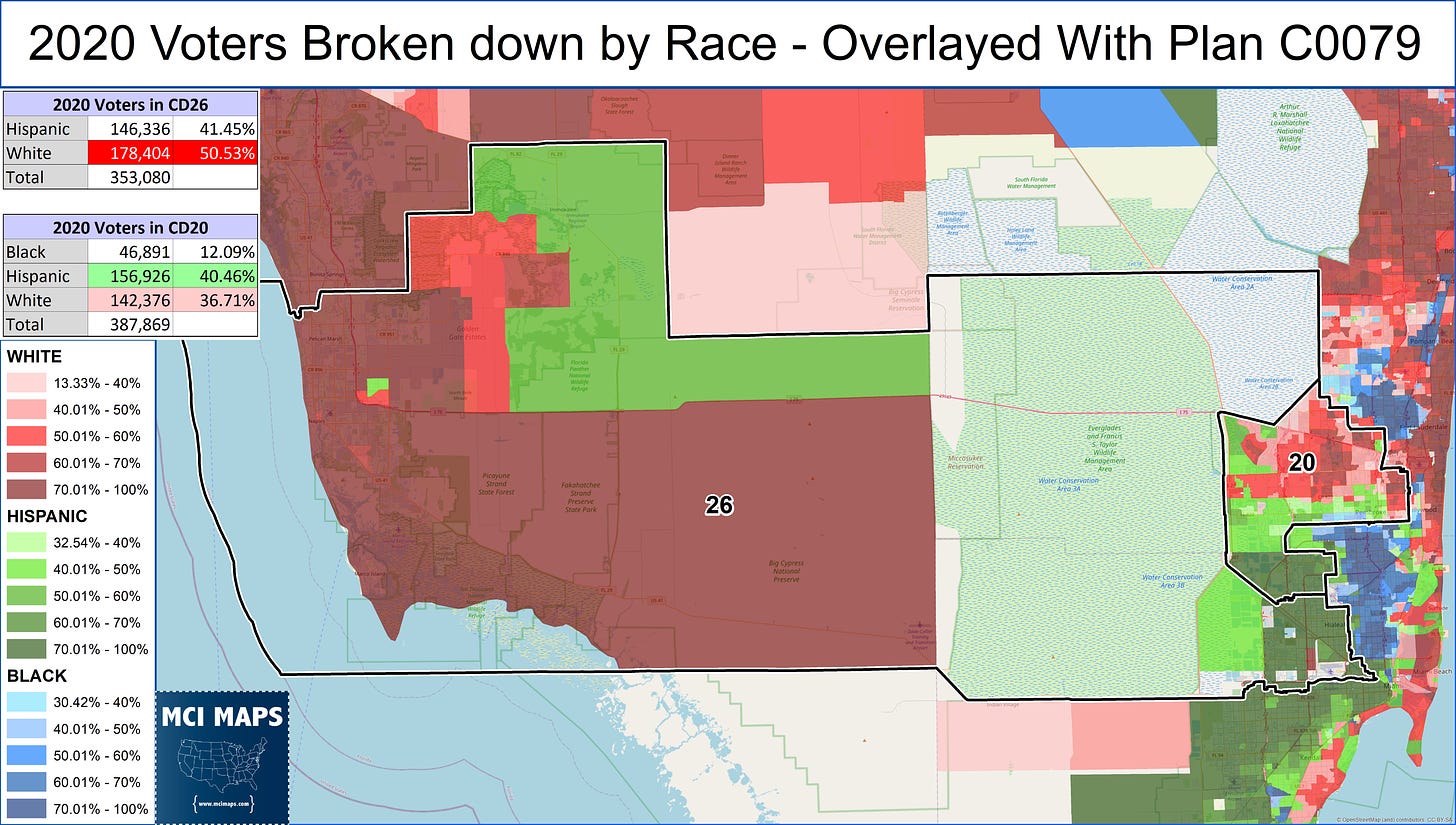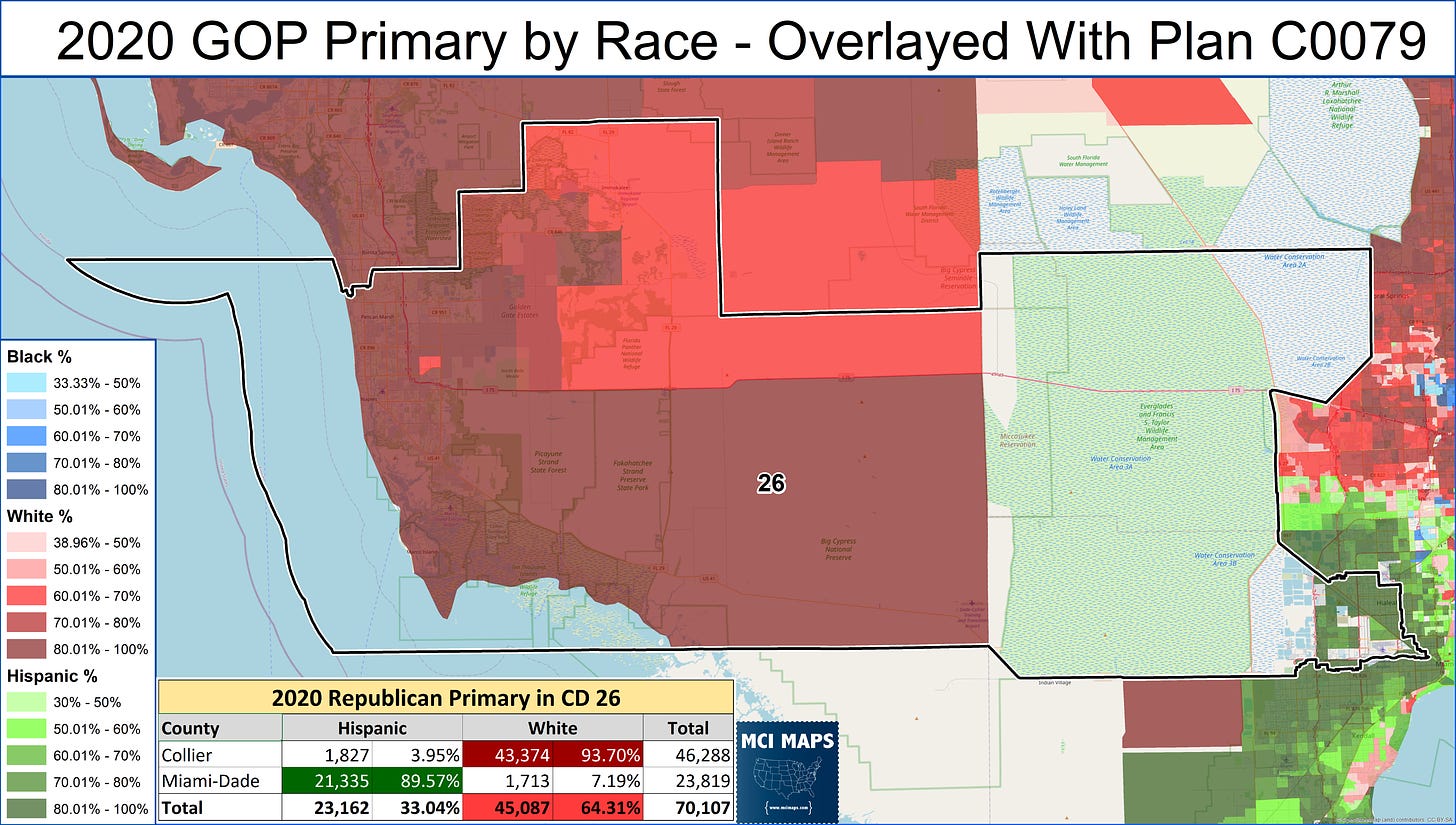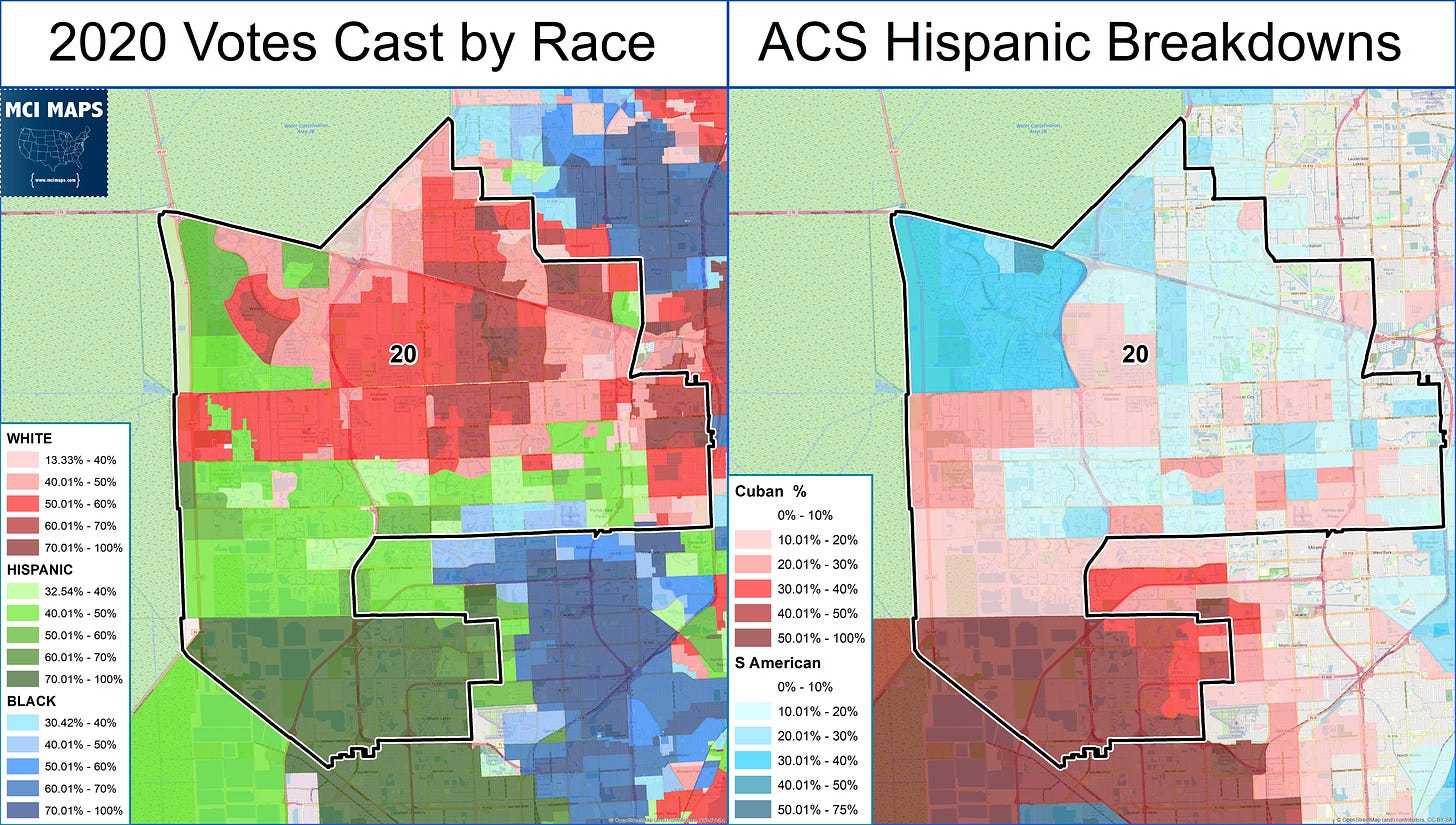Issue #30: Trying to Draw 5 Hispanic Congressional Districts in Florida
DeSantis claims he did, he didn't.
Its Thursday morning, January 20th, and its a big day in Florida redistricting. The Senate is poised to pass its Congressional redistricting plan. Yesterday the Senate held questions on the plan and heard amendments. The Senate unanimously approved an amendment from Democratic Senator Shev Jones to make small border changes to CD’s 24 and 25. This allowed the city of Miami Gardens to remain whole; with the rest of the map seeing no changes.
With the Senate approval a lock, the chamber is going to be on a crash course with Governor Ron DeSantis, who submitted his own plan. I covered that plan here.
This substack post, however, is about a broader issue that has emerged with the Congressional plan. How many Hispanic districts can be drawn?
Four vs Five Hispanic Seats
Anyone who knows even a little about Florida knows it has a sizable Hispanic population; which is continuing to grow. Florida got its first Hispanic district in 1982. It moved to two Hispanic seats in 1992. In 2002 it moved to three (all in South Florida). In 2012 (and the 2015 redistricting) a plurality Hispanic seat in Orlando was possible. Now all Senate drafts have the Orlando seat, CD9 here, at majority-Hispanic.
This marks the first time Florida will have four districts that are majority Hispanic voting-age population.
However, there has been a question, why no additional seats? It has been pointed out that Hispanic growth in central Florida is huge (it is). So why is no new Hispanic opportunity district to be found? Several Democratic lawmakers questioned this yesterday. Latino Justice and the League of Women voters have brought the issue up as well.
In response, Ron DeSantis’ plan, which nukes two of the four African-American districts, has FIVE Hispanic majority districts instead of four.
The difference in the DeSantis plan, however, is a fourth Hispanic seat in south Florida. Like the Senate plan, Orlando remains with one majority-Hispanic district.
So what is the story here? Is five Hispanic districts possible? I’m sorry to say I believe the answer is no. Let me explain
Creating a Hispanic District
For those of you who have followed my redistricting series over the last several months, you know about some of the tricky issues with drawing Hispanic districts. The most pressing issue is that to be a properly functional seat, it likely must be over 60% Hispanic in voting-age-population. This is something that Hispanic Republican lawmakers made sure to push in 1992’s redistricting sage (Congress and Legislative articles). Why? Because many Hispanic voters are refugees or non-citizens; especially in Miami-Dade. In addition, among voters themselves, Hispanics have lower voter turnout than white and black voters. As a result, lawmakers have made sure to use functional analysis (always comes back to that) to ensure seats marked as Hispanic actually perform as such.
The Miami-Dade state house plan perfectly highlights this. I delved into this in detail for an article a few weeks back; and I highly recommend you read it. But for example, look at HD117. This seat is on paper Hispanic. Its majority Hispanic in the census. However, its voting behavior means its more likely a black-opportunity seat; specifically because its heavily Democratic and majority-black in its DEM primary.
These voting behavior analysis tools have been critical for Florida redistricting; and are used by lawmakers to ensure they understand the seats they create. In the case of 117, everyone expects it to be an African-American district.
Census is not enough.
Where the Maps Stand
So what does this mean for Florida’s Congressional plan? Well lets look at the two big plans in question. Below is the five most Hispanic seats for both the Senate plan and the DeSantis plan. I include census data as well as voting behavior data.
So lets break these down piece by piece. Lets actually start with CD9. In both plans, CD9 is the Orlando-based Hispanic seat. Both plans have a solidly Democratic, majority-Hispanic seat. However, notice what happens when we look at voting behavior. Registered voters and turnout fall below 50% Hispanic. The Democratic primary (most important for a Democratic seat) is under 40% Hispanic. The Orlando seat is majority-Hispanic in the census, but not in voting. Now, this will continue to change as the decade goes on; and the Hispanic voting population grows. But to answer why a 2nd Hispanic seat isn’t possible in Orlando, its because of this drop-off. First, there is not enough Hispanic voters to create a two majority-Hispanic seats in central Florida. In addition, turnout drops mean cracking up the 9th to create a second opportunity seat could cause problems in the 9th itself.
Now, we look at South Florida. The Senate plan has three solid Hispanic seats; which remain Hispanic even as shares drop in general and primary voting. However, the DeSantis plan, which has four supposed Hispanic seats, really only has two secured. CD26 and 20 have problems. Lets go over these
Districts 20 and 26
I delved into this on my last substack, but I’ll repeat it here. First off, as we see, both of these seats are far from majority Hispanic in voting for the general. The 26th makes the very bizarre decision to link almost all of lilly-white Collier with Hialeah; a mecca of the Cuban exile movement.
District 26, based on the partisan data, is a very likely Republican seat. However, its Republican primary is 2-1 white over Hispanic. This plan gives white voters an advantage; and its hard to imagine Collier voters in the west just letting Dade chose their nominee.
There is a very strong argument that CD26 is white in functional analysis.
District 20 has multiple issues. It is fairly Democratic, but Hispanics only make up 22% of the primary vote. On top of this, the Hispanic voters of the district are hardly homogeneous. The district lines match the heavily Cuban Hialeah area (city is split) with a more diverse and growing Hispanic block in Broward county. These voters are often casting different partisan ballots and often in different primaries. Those Hialeah Cuban voters are largely voting in GOP primaries, not Democratic. So the Hispanic community doesn’t have uniformed voting to help elect a candidate of their choice.
In their effort to draw five Hispanic districts, the DeSantis administration has drawn a plan that would likely just have three Hispanic districts and two Hispanic-in-name-only seats.
I have been unable, based on the census data and voting registration data, to draw more than four functional Hispanic seats.
Looking Ahead
The biggest issue is simply how big Congressional seats must be. Since Florida only got one new seat, it limited what could be done. The first goal had to be to get the 9th to majority Hispanic, but as I’ve shown its not packed; barely over 50%. However, in that Orlando area there will now be two additional Hispanic State House districts; a reflection of the growth in the community. Unfortunately the growth just isn’t enough for another opportunity Congressional seat - yet. I imagine the next census could change that.











